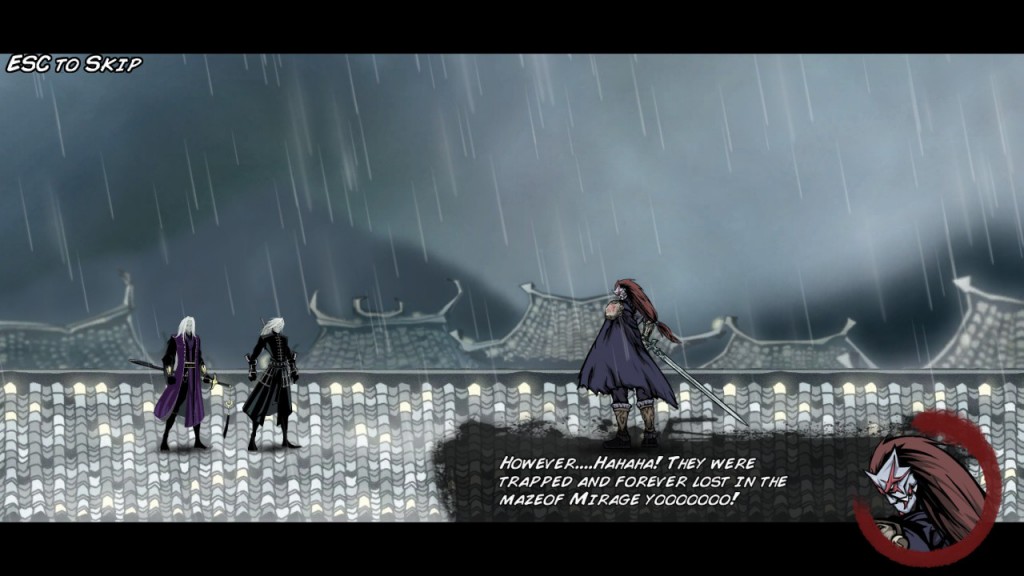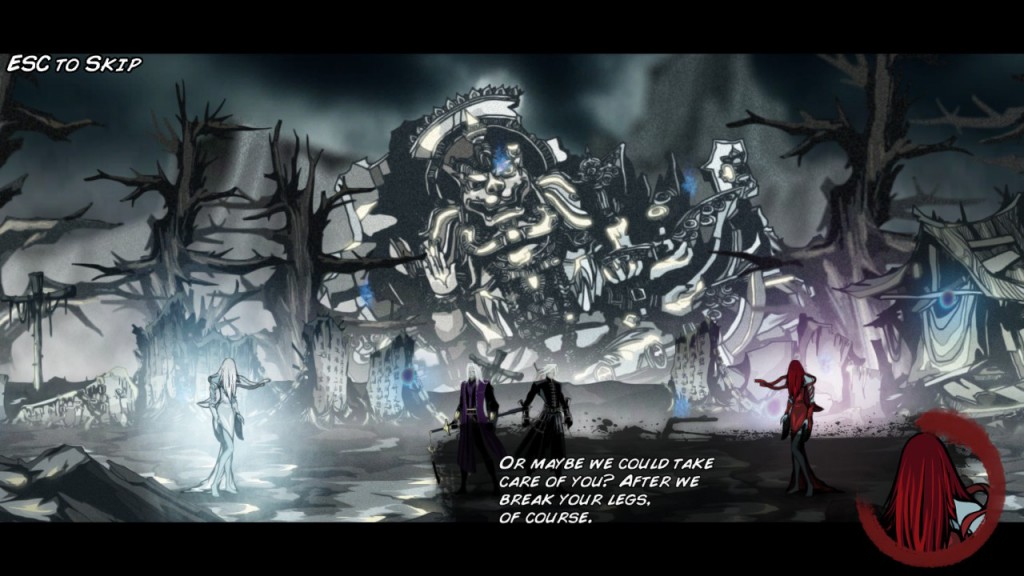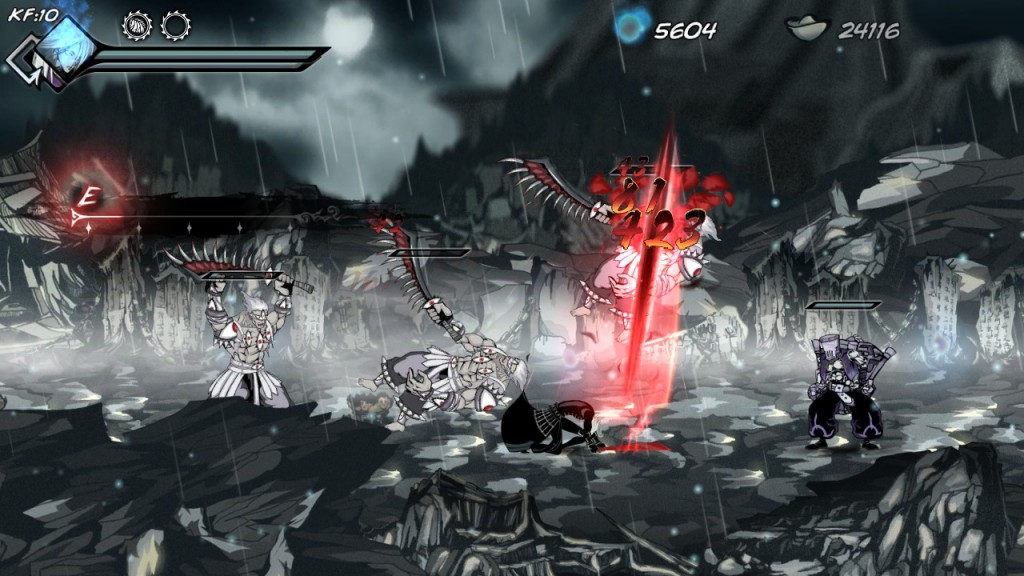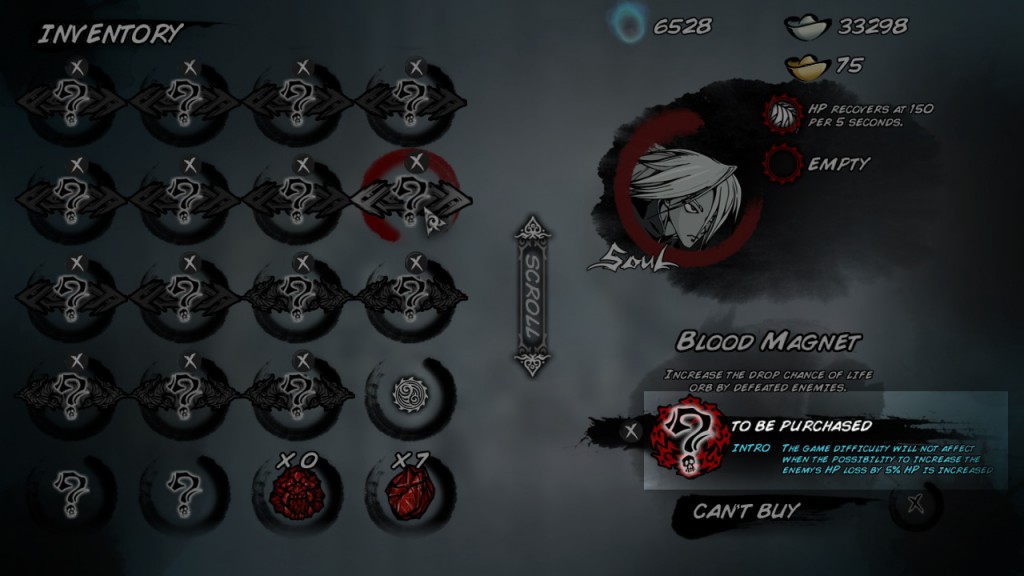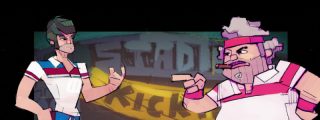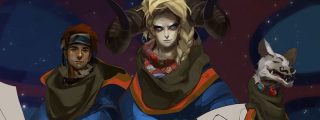RainBlood Chronicles: Mirage is a brawler with a very obvious Chinese styling to it. The game opens with a cutscene that doesn’t make a whole lot of sense, partly because the story isn’t well explained and partly because the game just exhibits poor English in general. Apostrophes don’t exist and Engrish is abound. You play as two switchable characters; brothers named Soul and Shang. They both perform differently, so Soul is good for evasion whereas Shang is good at… well, I don’t know what. Truth is, I never ever use him because he can’t dodge, and there’s no blocking in this game.
But I’m getting ahead of myself; here’s my best attempt to explain how the plot works. It is told as a “Wuxia” story, which from my very brief research just seems to mean a story about warriors who set out and fight stuff, and that’s definitely not off the mark here. It’s basically a lot of cutscenes of an old man telling a story to a young child, illustrated with paintings. Whatever the storytelling style, it seems to be rubbing off on the review because my thoughts feel equally disjointed.
RainBlood has a tough time maintaining any semblance of a plot beyond its whimsical and unexplained charms. For instance, at some point Soul and Shang set out to the deep innards of a mountain to discover two magical sisters who flirt with the two of you very briefly before going hostile and trying to blow you apart with magic, engaging a boss battle. When the level is over, it plays a cutscene where the old man telling the story is asked by the child where the sisters came from; he quickly hushes the child and says that’s for another time.
And so it seems that this is the core of the story in RainBlood: There isn’t really one, or at least not a cohesive one. It’s more like a telling of a bunch of nursery rhymes (albeit Chinese ones) in the format of a brawler… perhaps fitting, a story that isn’t deep matched with a genre that also isn’t very deep. So whether the story is even a negative point is hard to say.
At any rate, if you’re interested in the story, you can always look into Jade’s Eye at your safehouse and read some paragraphs about the main characters… beware again, for some broken English exists here as well.
The art style is pleasing to look at but not always good for gameplay. It relies on a lot of desaturated colors, especially sort of rainy day blues and reds, which means effects flying around on-screen are hard to differentiate amongst other effects.
Good thing then that at least on Novice and Normal difficulties, you can basically just bamf around as Soul and repeatedly do solo-button combos to get through most situations. Combat is graded constantly as you play, and even when I think I’m doing well, the end-level score inevitably comes up as E (the lowest possible score) implying I’m doing something very very wrong even though at times I’m pretty efficient at killing things quickly. Combat feels good when you can pull off what you’re trying to do.
Again, Soul and Shang operate differently. Soul can poof into smoke and appear a few feet forward, allowing you to dodge attacks and get behind enemies. If you do this right before an enemy’s melee attack or arrow hits you, time slows down and you’ll be briefly prompted to use your strong attack; if you do, you’ll perform an instant kill on small enemies (or do significant damage to bosses). Shang seems useless or at least to the likes of me, and might be better suited by advanced players. The same button that makes Soul turn to smoke generates this little golden sword icon next to Shang. He can either use it in his next strike to echo the strike as a projectile or use it to perform a double jump. Neither of which is really anything Soul can’t do, and Soul’s added benefit is he can of course completely evade attacks. In a game with no blocking, it felt like a no-brainer to use Soul all the time.
Levels are played out in a sort of linear overworld fashion where you beat a level and progress to the next, or go back to replay old ones. Money and tokens are earned based on the difficulty and your performance during the level and can be spent at your safe area to upgrade your combos or buy slotted passive items to provide permanent bonuses to Soul and Shang individually. It definitely adds some needed depth to the game, though the descriptions for a lot of the upgrades just… don’t make sense. Again, it’s the Engrish at fault here. Some of these upgrades can change how you play; for instance, one will drop your HP to 1 but double all of your outgoing attack damage. Others are more tame, like providing health regeneration or slowing the speed at which you lose combo grades.
If the game were more readable in combat situations from a visual standpoint and the English were more readable from a, well, literal reading standpoint, the game might fare better. If you’ve got a particular fascination for Chinese themes and brawler/fighters, pick it up. It’s not a bad game by any means. It’s pretty darn good, and there’s good replay here as well, it’s just not necessarily for me.


